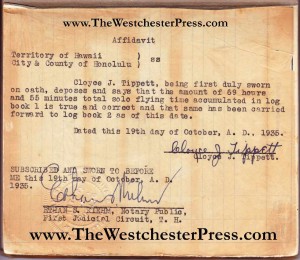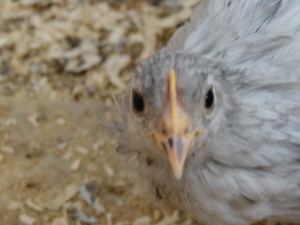This is one of my favorite blog post series about the life and times of my grandfather, Col. C. J. Tippett – and the memoir he wrote which I turned into a book by wrapping his story in research and background information.
Col. C. J. Tippett pursued his passion for aviation in a time of history that brought him across the paths of many famous people, who were then able to meet him.
Some of them are very famous, like Ernest Hemmingway and General Hap Arnold.
Some of them are less famous, but no less significant, like Ethan S. Kiehm.
Mr Kiehm met Tip in the Territory of Hawaii on October 19th, 1935 when Tip needed a notary public to certify his pledge of 69 hours nad 55 minutes of total solo flying time.
Tip was a private in the US Army and on his way to a flying career. He was already banking flight time on his own, in addition to anything he could do through the army, and getting his flight log officially recognized was an important step.
Ethan S. Kiehm was in Honolulu and ready with his notary stamp that day because he’d been born there, to Korean immigrant parents, and is now considered to be the first American-born Korean in Hawaii.
This was important to both Korea and America because, during his life, Ethan Sungkoo Kiehm went from being a notary public in Honolulu to being the aide to the first president of the Republic of Korea, Syngman Rhee – while Rhee led South Korea through the Korean War.
With a foot in both cultures, Mr. Kiehm provided a unique bridge between Korean and American leadership during a critical time. When he left the service of Syngman Rhee, Kiehm returned to Hawaii and joined the American military. There’s an entire story in that alone; of the Korean diaspora to Hawaii, Rhee’s journey to leadership, Kiehm’s participation and perspective, and Korean history.
Kind cool, huh? I love this kind of thing.
The book, now maybe titled “When No One Else Would Fly” is almost ready for release. Contact me if you’d like to be added to the announcement list. I don’t ever sell your contact info.
I’m in the final edit stage and have discovered, with thanks to my editor, that I’ve punked all the title capitalization throughout the manuscript and must correct it. NOW I know that President Syngman Rhee of South Korea gets capitalized. But if I’m writing about how Ethan S. Kiehm was aide to the president of South Korea, then I don’t capitalize anything but the country. That doesn’t feel very respectful, but…
It is the duty of the self published writer to make sure the manuscript is as correct as we can get it, and fight the common perception that self published books are not adequately edited. So I must somehow strive to remember that Col. C. J. Tippett, USAF Ret. met Notary Public Ethan S. Kiehm when Tip was a private in the army and Kiehm was a notary public for the First Judicial Circuit, Territory of Hawaii in 1935!









